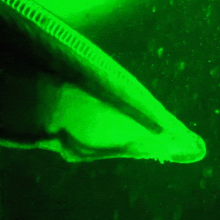Branchiostoma floridae
| Branchiostoma floridae | |
|---|---|

| |
| Microscopy observation of a living Branchiostoma floridae exhibiting its natural GFP expression[1][2] | |
| Scientific classification | |
| Domain: | Eukaryota |
| Kingdom: | Animalia |
| Phylum: | Chordata |
| Subphylum: | Cephalochordata |
| Class: | Leptocardii |
| Family: | Branchiostomatidae |
| Genus: | Branchiostoma |
| Species: | B. floridae
|
| Binomial name | |
| Branchiostoma floridae | |
Branchiostoma floridae, the Florida lancelet, is a lancelet of the genus Branchiostoma. The genome of this species has been sequenced, revealing that among the chordates, the morphologically simpler tunicates are actually more closely related to vertebrates than lancelets.[4] An embryo of a Florida amphioxus (Branchiostoma floridae) has a larval pharynx with gill slits that is asymmetrical. The gill slits in the larval pharynx form in the center of the embryo when it is in its earliest stage of development (primordial) meaning the thick layer of endoderm is overlapped by a thin layer; which aids into making the B. floridae asymmetrical from left to right. [5] The lancelet Branchiostoma floridae maintains a high level of Fox transcription factor gene diversity, with 32 distinct Fox genes in its genome,[6] and 21,229 clusters of cDNA clones, making it very useful to the research community.[7]
Life and physiology
[edit]The breeding season for Branchiostoma floridae typically spans from late spring to late summer, with spawning occurring every 1 to 15 days.[8] Sexual maturity also occurred similarly in both males and females.[8]
References
[edit]- ^ Baumann, D.; Cook, M.; Ma, L.; Mushegian, A.; Sanders, E.; Schwartz, J.; Ron Yu, C. (2008). "A family of GFP-like proteins with different spectral properties in lancelet Branchiostoma floridae". Biology Direct. 3. doi:10.1186/1745-6150-3-28. PMC 2467403. PMID 18598356. Art. No. 28.
- ^ Deheyn, D.D.; Kubokawa, K.; McCarthy, J.K.; Murakami, A.; Porrachia, M.; Rouse, G.W.; Holland, N.D. (2007). "Endogenous green fluorescent protein (GFP) in amphioxus". The Biological Bulletin. 213 (2): 95–100. doi:10.2307/25066625. PMID 17928516.
- ^ Hubbs, C.L. (1922). "A List of the Lancelets of the World with Diagnoses of Five New Species of Branchiostoma". Occasional Papers of the Museum of Zoology, University of Michigan. 105: 1–16. hdl:2027.42/56544.
- ^ Putnam, N. H.; Butts, T.; Ferrier, D. E. K.; Furlong, R. F.; Hellsten, U.; Kawashima, T.; Robinson-Rechavi, M.; Shoguchi, E.; Terry, A.; Yu, J. K.; Benito-Gutiérrez, E. L.; Dubchak, I.; Garcia-Fernàndez, J.; Gibson-Brown, J. J.; Grigoriev, I. V.; Horton, A. C.; De Jong, P. J.; Jurka, J.; Kapitonov, V. V.; Kohara, Y.; Kuroki, Y.; Lindquist, E.; Lucas, S.; Osoegawa, K.; Pennacchio, L. A.; Salamov, A. A.; Satou, Y.; Sauka-Spengler, T.; Schmutz, J.; Shin-i, T. (Jun 2008). "The amphioxus genome and the evolution of the chordate karyotype". Nature. 453 (7198): 1064–1071. Bibcode:2008Natur.453.1064P. doi:10.1038/nature06967. ISSN 0028-0836. PMID 18563158.
- ^ Ono, Hiroki; Koop, Demian; Holland, Linda Z. (2018-08-01). "Nodal and Hedgehog synergize in gill slit formation during development of the cephalochordate Branchiostoma floridae". Development. 145 (15): dev162586. doi:10.1242/dev.162586. ISSN 0950-1991. PMID 29980563.
- ^ Yu, Jr-Kai; Mazet, Francoise; Chen, Yen-Ta; Huang, Song-Wei; Jung, Kuo-Chen; Shimeld, Sebastian M. (December 2008). "The Fox genes of Branchiostoma floridae". Development Genes and Evolution. 218 (11–12): 629–638. doi:10.1007/s00427-008-0229-9. PMID 18773219. S2CID 7820676.
- ^ Yu, Jr-Kai; Wang, Ming-Chih; Shin-I, Tadasu; Kohara, Yuji; Holland, Linda Z.; Satoh, Noriyuki; Satoh, Yutaka (December 2008). "A cDNA resource for the cephalochordate amphioxus Branchiostoma floridae". Development Genes and Evolution. 218 (11–12): 723–727. doi:10.1007/s00427-008-0228-x. PMID 18773220. S2CID 22658341.
- ^ a b Stokes, M. Dale; Holland, Nicholas D. (1996). "Reproduction of the Florida Lancelet (Branchiostoma floridae): Spawning Patterns and Fluctuations in Gonad Indexes and Nutritional Reserves". Invertebrate Biology. 115 (4): 349–359. doi:10.2307/3227024. ISSN 1077-8306.
